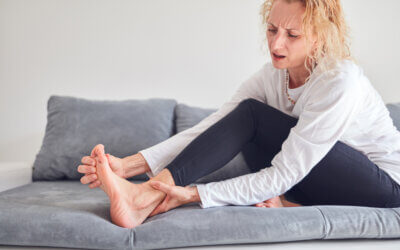Experiencing a loud pop in your knee that is followed by pain can be a disconcerting sensation. This sudden occurrence can significantly affect your mobility and daily activities. When you hear a loud pop in your knee that is followed by pain, it could be indicative of a variety of underlying issues. The good news is, once the underlying issue is determined, you can then address it and begin your recovery. Often, physical therapy is a beneficial treatment choice in helping knee issues to heal.
Common Causes for a Pop Sound and Pain in the Knee?
If you’ve experienced a loud pop in your knee that was followed by pain, you’re sure to be wondering what just happened. This could have been due to a variety of issues including:
- Ligament injury — A sudden pop in your knee could be due to the result of damaging or tearing one of your knee’s ligaments. These ligaments include the anterior cruciate ligament (ACL), posterior cruciate ligament (PCL) or medial collateral ligament (MCL). These ligament injuries are often caused by twisting or high-impact movements during activities. This injury is commonly seen in athletes and can affect up to 200,000 people a year.
- Meniscus tear — The meniscus is cartilage in the knee that acts as a cushion. A pop followed by pain could indicate a tear in the meniscus. This can happen during activities that involve the sudden twisting or pivoting of the knee. Meniscus tears affect approximately 1 million people a year.
- Tendon rupture — A loud pop could be indicative of a tendon rupture. The most likely tendons to experience this injury are the patellar tendon or the quadriceps tendon. These injuries often occur during forceful contractions or sudden movements.
- Kneecap (patella) dislocation — If the kneecap is dislocated from its natural position, it could create a popping sensation accompanied by severe pain. This injury may occur during a fall or a sudden change in direction.
- Cartilage damage — Damage to the articular cartilage that covers the surface of the knee joint can lead to pain and a popping sensation. This can result from wear and tear over time or due to a traumatic injury.
Immediate Steps to Take After Experiencing a Pop Sound in Your Knee
If you have experienced a loud pop in your knee that is followed by pain, it is crucial to immediately take actions to address the issue. These actions can include:
- Protection.
- Rest.
- Ice.
- Compression.
- Elevation.
You may also help reduce your pain and inflammation by taking an over-the-counter anti-inflammatory medication. You should consult your medical provider before taking medications for an extended amount of time. You should seek immediate medical attention for a thorough evaluation and diagnosis. In the event of a severe injury, an orthopedic specialist may be needed to assess the extent of your injury further. After the diagnosis of the issue, appropriate treatments will be recommended.
When Should You Seek Physical Therapy for Your Knee Pain?
After your injury or condition has been evaluated and diagnosed, you may receive the recommendation to pursue physical therapy. Physical therapy can be a valuable treatment option if you have experienced a loud pop in your knee and it is followed by pain. Physical therapy treatments are intended to help you manage your pain, improve your range of motion and increase your strength. These can be done through a variety of techniques including:
- Therapeutic exercises — Therapeutic exercises should be approached with caution and followed how your physical therapist guides you. These exercises may start with the focus of gentle range-of-motion movements intended to help reduce stiffness and discomfort. More specific exercises and their intensity should be tailored specifically to your condition and any other underlying issues.
- Manual therapy — Manual therapy involves hands-on techniques like soft tissue mobilization and joint mobilization. In manual therapy, potential alignment issues that could be causing your pain can be addressed. Specific techniques will be determined by your condition and your physical therapist’s decision on how to best approach your treatment.
- Electrical stimulation — Electrical stimulation can provide a low-level current to the knee. This stimulation can help block nerves to keep pain signals from being sent to the brain. It can also help boost circulation and promote muscle relaxation.
- Dry needling — Dry needling is a technique used by certified physical therapists by inserting thin, sterile needles into trigger points in the knee. These needles can help release muscle tension and reduce pain.
- Sports therapy — Sports therapy is a specialized branch of physical therapy and can help address knee injuries to rehabilitate them properly and help prevent the injury from occurring again.
Your physical therapist may also recommend that you use heat and cold therapy in between visits to continue to support your recovery. Heat therapy can help increase circulation, relax muscles, and reduce pain and stiffness in your knee. Cold therapy uses cold packs or ice to help reduce inflammation and numb the area. This can provide relief from acute pain and swelling. It is essential that a barrier is used between your knee and the cold packs or ice. Prolonged exposure to the cold packs or ice can cause tissue and nerve damage.
How Continuum Wellness Can Help with Your Knee Injury
Continuum Wellness is here to help provide you with the expert care and support you need to cope with knee pain. We can help you determine the cause of your knee issue and design a customized treatment plan designed around your specific needs. We can help you alleviate your pain and regain the strength and function in your knee that can be impacted by your injury or condition.
Contact our team today for more information or to schedule an initial appointment.



